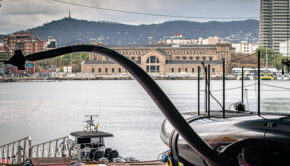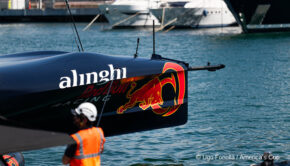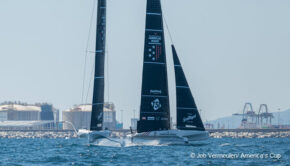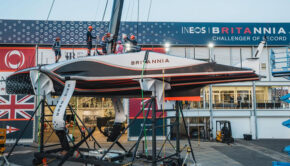America’s Cup: Sinking of One Australia
Published on March 5th, 2019
The dramatic moments on the 5th of March 1995, when during round four in the round robin stage of the America’s Cup challenger series, and in a match race between One Australia and Team New Zealand, the Australian boat split and sunk within two minutes off San Diego, CA.
This was an unprecedented event, and while it occurred when the internet was new, significant commentary now exists online. Alongside this YouTube video is a post by King Cliff which seeks to offer closure to the speculation on how such a complete failure could happen:
I built this boat. Yes, the primary winch failed and they transferred the load to I think the running back stay winch. I’m not a sailor, just a boat builder. Either way, it’s like trying to break a stick with your hands close together and then moving them further apart. The boat wasn’t designed to take the load applied at such a distance.
Plus, these boats weren’t designed to be in conditions like this (18-20 knots). They are flat water boats. The race should have been called off. If it was flat it probably wouldn’t have broken even with the winch failure.
A design flaw? In a way yes and no. It only had two bulk heads. Mast bulkhead and a keel bulkhead and both were mealy ring frames and not full bulkheads. But that wasn’t the true problem IMO. The boat was as hollow as a drum. It sure was cutting edge but it had no longitudinal strength. No beams running fore and aft to stop it breaking in half.
I brought this up three times but was told I wasn’t being paid to think. All I wanted to do was put two short longitudinal beams running maybe a few meters fore and aft of the keel box. But no. Weight was the key factor and the order of the day. I think if they were in it may not have broken. It certainly wasn’t too thin a carbon layup.
Why did it go down so fast? The hull and deck finished weighed only 1.1 tonnes. Incredibly light for an 80 foot maxi. The mast was 135 feet long and the single longest carbon structure ever produced. The mast had 40 tonnes of load pulling down on the mast bulkhead. But the cause of it sinking so fast was the foil and bulb attached below had over 17 tonnes of metal combined.
The foil was solid stainless steel weighing 5 tonnes alone attached to a 12 tonne lead bulb below it with small stainless steel wings off of it. So a 1 tonne broken cork being pulled down by 17 tonnes of steel and lead. Down she went!
It certainly wasn’t badly built. It was a masterpiece of construction built to incredibly high standards. NASA standards. In fact NASA took interest in what we were doing as it was built to the same layup as the space shuttle and we were treading new ground and finding breaking points with new technology.
Why did the three fellas stay on the front for so long? Because there was confusion as to if someone was still down below. You can see one guy leaning down shouting through the forward hatch. Inside was full of sails and nothing else. Up to two people are down there at any one time feeding sails up through the hatches or dragging them back down below. Throw in a few hundred tonnes of water and a recipe for disaster for anyone below. Once they were somewhat sure no one was below, they jumped off. They had no choice anyway.
But the key point to make is that the Kiwi boat had the boat speed on us from the start. Even if nothing went wrong they were going to beat us hands down.








 We’ll keep your information safe.
We’ll keep your information safe.